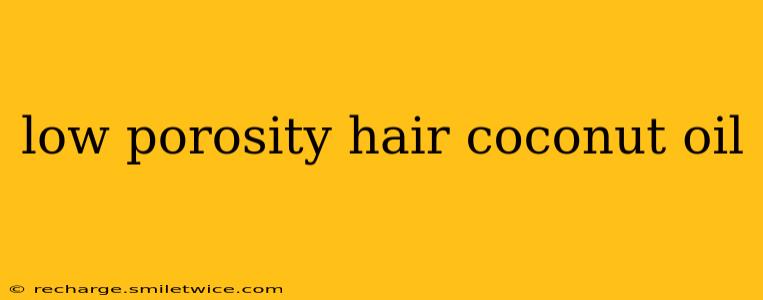Low porosity hair, characterized by tightly sealed cuticles, presents unique challenges when it comes to hydration and product absorption. While many tout coconut oil as a miracle hair product, its effectiveness for low porosity hair requires a nuanced understanding. This comprehensive guide explores the relationship between low porosity hair and coconut oil, addressing common concerns and offering practical advice.
What is Low Porosity Hair?
Low porosity hair has tightly overlapping cuticles, making it difficult for moisture and products to penetrate the hair shaft. This can lead to product buildup, a feeling of heaviness, and difficulty in achieving desired hydration levels. Identifying your porosity is crucial for tailoring your hair care routine. You can test your porosity by performing a strand test: place a strand of hair in a bowl of water. If it floats, you likely have low porosity hair. If it sinks quickly, you likely have high porosity. If it sinks slowly, you likely have medium porosity.
Can You Use Coconut Oil on Low Porosity Hair?
Yes, but with caution and the right technique. Coconut oil, while beneficial for many hair types, can be overly heavy for low porosity hair, potentially leading to buildup and a greasy look. The key is using it strategically and in moderation.
How to Use Coconut Oil on Low Porosity Hair
The best way to use coconut oil on low porosity hair is in small amounts and on specific areas. Applying a large amount to the entire scalp and hair will likely lead to buildup. Instead, focus on the ends, applying a tiny amount, no larger than the size of a pea. Using it as a pre-poo treatment (before shampooing) and focusing on only the ends can help.
H2: Does Coconut Oil Seal in Moisture in Low Porosity Hair?
While coconut oil's ability to "seal" moisture is often discussed, it's more accurate to say it creates a barrier. This barrier can prevent moisture from entering the hair shaft if applied improperly, leading to dryness. However, if applied sparingly and strategically to already-moisturized hair, it can help prevent existing moisture from escaping. The crucial factor is the hair's hydration before applying the oil.
H2: How Often Should I Use Coconut Oil on Low Porosity Hair?
This depends on your hair's response. Start with once a week as a pre-poo treatment and observe your hair's reaction. If you experience buildup, reduce the frequency to every two weeks, or even monthly. Listen to your hair; it will tell you what works best.
H2: What are the Benefits of Coconut Oil for Low Porosity Hair (If Used Correctly)?
When used correctly, coconut oil can offer some benefits for low porosity hair:
- Added shine: A small amount can add a healthy sheen to the hair.
- Reduced breakage (on ends): By moisturizing the ends, it can minimize breakage, especially at the ends.
- Protection against environmental stressors: It can provide a protective barrier against the sun, wind, and other elements.
H2: What are the Drawbacks of Coconut Oil for Low Porosity Hair?
Incorrect usage can result in several drawbacks:
- Buildup: This is the most common problem, leading to a weighed-down, greasy appearance.
- Blocked follicles: Excess oil can clog hair follicles, impeding hair growth.
- Dryness: Ironically, improper application can prevent moisture from penetrating, leaving your hair drier.
Alternative Moisturizers for Low Porosity Hair
If coconut oil isn't working well, several other moisturizers are better suited for low porosity hair:
- Water-based leave-in conditioners: These are lightweight and easier to absorb.
- Lightweight oils: Consider jojoba oil, grapeseed oil, or argan oil, which are less heavy than coconut oil.
- Aloe vera gel: A great natural moisturizer that’s often better tolerated by low porosity hair.
Conclusion
Coconut oil can be a valuable addition to a low porosity hair routine, but only when used judiciously. Understanding your hair's unique needs and experimenting with different application methods will help you determine if coconut oil is right for you and how to use it effectively. Remember, less is often more when it comes to low porosity hair care. Prioritizing proper hydration and choosing lightweight products are key to maintaining healthy, manageable hair.
